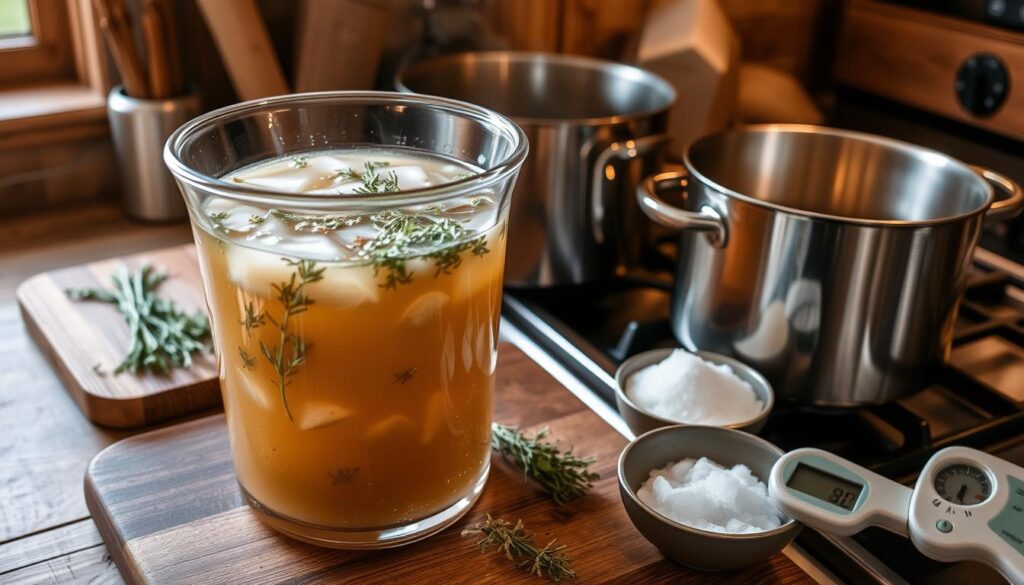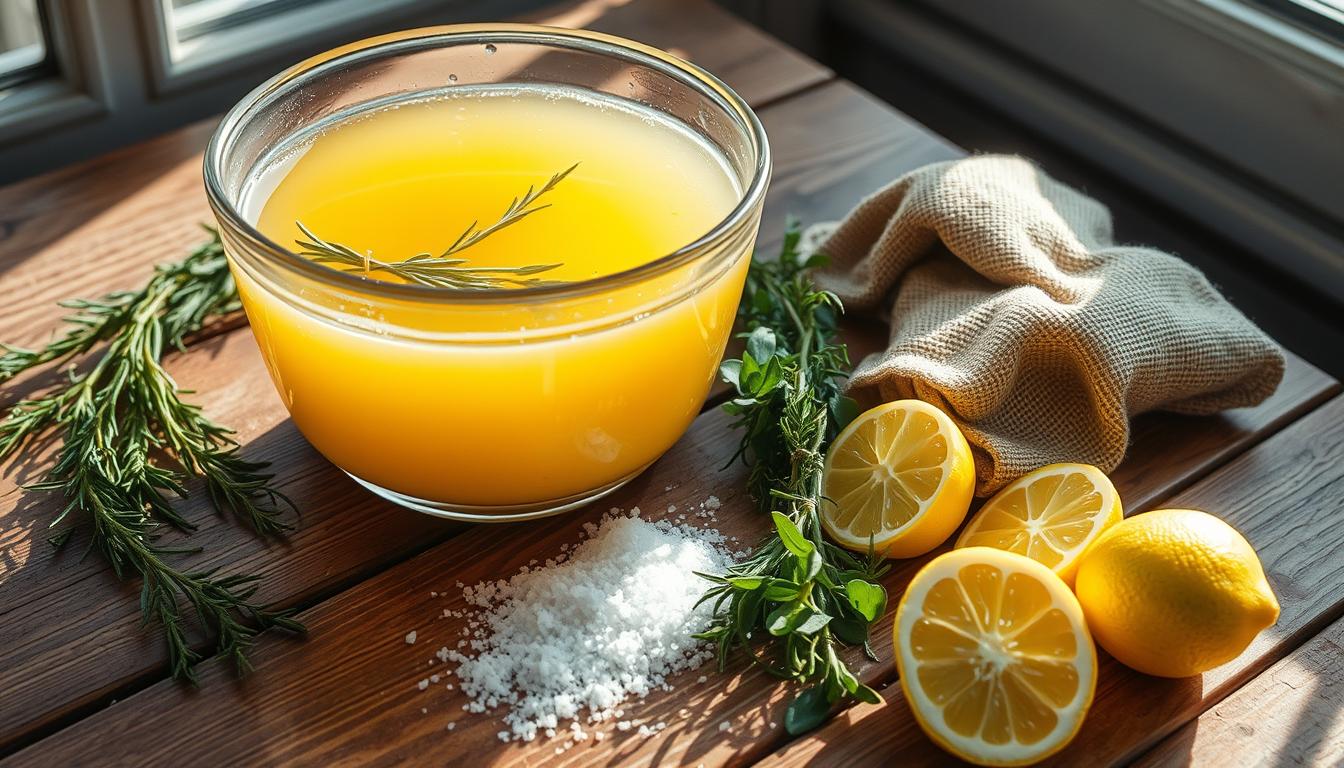Growing up, my grandma was known for her amazing chicken dishes. She used a simple chicken brine to make even the most basic chicken taste incredible. Watching her in the kitchen, I knew I had to learn this secret.
Now, I’m happy to share the chicken brine recipe that’s been in our family for years. It only needs five simple ingredients to make chicken juicy, tender, and full of flavor. This brine works for any chicken type, making meal prep easy and fun.
Key Takeaways
- This simple chicken brine recipe uses just 5 ingredients: water, kosher salt, soy sauce, sugar, and olive oil.
- The brine can be used for whole chickens, bone-in pieces, or skinless breasts, with varying brining times.
- The quick brine method takes as little as 2 hours, making it ideal for last-minute meal preparation.
- Brining results in perfectly tender and flavorful chicken every time.
- The brine has a higher salt content than most, allowing it to work more effectively and quickly.
Understanding the Magic Behind Chicken Brining
Brining is an easy method that works wonders, enhancing the juiciness and flavor of chicken to create a truly mouthwatering dish. It involves submerging the chicken in a salt-based solution with aromatic herbs and spices. This process enhances flavor and keeps the chicken tender and moist, even when cooked to perfection.
How Brining Tenderizes Meat
The salt in the brine breaks down the chicken’s muscle fibers. This allows the meat to absorb moisture and retain it during cooking. This makes the chicken juicy and succulent, no matter how you cook it.
The Science of Moisture Retention
The brine’s magic comes from its ability to draw water into the meat. As the salt dissolves, it creates a solution that the chicken’s fibers absorb. This influx of moisture tenderizes the meat and helps it keep its juices during cooking.
Why Brining Makes a Difference
Brining is especially good for lean proteins like poultry, which can dry out easily. By brining the chicken, you create a protective barrier against overcooking and moisture loss. This results in a juicier, more flavorful bird that will impress your taste buds.
“Brining is a game-changer for anyone who wants to achieve perfectly moist and succulent chicken every time.”
Essential Ingredients for a Simple Chicken Brine
Creating a basic chicken brine is simple. You need water, kosher salt, and optional flavor enhancers. Recipes might add soy sauce, sugar, or olive oil, but water and salt are the basics.
Water helps the meat stay hydrated and absorb flavors. Kosher salt adds a savory taste and makes the chicken tender.
You can add flavor boosters to your brine. Some favorites include:
- Soy sauce – for added salt and umami notes
- Sugar – for a touch of sweetness and to promote browning
- Olive oil – to ensure moist and tender chicken
For a more flavorful brine, try garlic, peppercorns, herbs, and citrus. They add subtle yet exciting tastes. But, a simple salt and water mix is versatile. It lets you tailor the brine to your recipe and taste.
“Brining stands out as a straightforward and reliable method to keep chicken moist, tender, and bursting with flavor.”
The Perfect Salt-to-Water Ratio for Brining
For a simple chicken brine, use a higher salt-to-water ratio. This makes brining faster and more effective. The best ratio is 5 tablespoons of kosher salt for every 2 cups of water. This helps the chicken soak up moisture and flavor quickly, making it juicy and tasty.
Kosher Salt vs. Table Salt
Always choose kosher salt over table salt for your brine. Kosher salt has bigger crystals and tastes less salty. Because of this, you’ll need to use more of it in your brine.
Water Temperature Guidelines
Start by dissolving the salt in warm water for the best brine. This ensures the salt mixes well. After dissolving, cool the brine down with ice or the fridge. This keeps the chicken from cooking too much, making it tender and juicy.
| Brine Ratio | Kosher Salt | Table Salt |
|---|---|---|
| Standard Brine | 1 tablespoon per 1 cup of water | 3/4 tablespoon per 1 cup of water |
| Chicken Brine | 5 tablespoons per 2 cups of water | 3 tablespoons per 2 cups of water |
Remember, the secret to a great salt brine for chicken is finding the perfect simple chicken brine ratio.The key is finding what works best for your needs.
Step-by-Step Brine Preparation Method
Making a simple easy chicken brine recipe or simple chicken brine is easy. It can make your chicken taste better and stay juicy. Here’s a beginner’s guide to getting started:
- In a medium saucepan, mix 4 cups of cold water and 4 tablespoons of kosher salt. You can add 1 tablespoon of garlic powder for more flavor, if you like.
- Put the saucepan on medium heat and let it boil. Stir it a few times until the salt is all dissolved.
- Take the saucepan off the heat, cover it, and let it sit for 10 minutes. This lets the flavors mix well.
- Pour the hot brine into a big bowl with ice cubes. Stir until the ice melts, cooling the brine down.
- When the brine cools, put your 4 boneless, skinless chicken breasts (each 6 ounces) in it. Make sure they’re all covered.
- Place a cover over the bowl and refrigerate it. Let it brine for 15 minutes to 2 hours, depending on what you prefer.
By following these steps, you can make a tasty and juicy easy chicken brine recipe or simple chicken brine. It will make your chicken dishes even better.
“Brining chicken is a game-changer, adding moisture and flavor that you simply can’t achieve any other way.”
Recommended Brining Times for Different Cuts
Getting juicy, flavorful chicken starts with the right brine. The brining time changes based on the chicken cut. For a whole chicken, brine it for at least 4 hours or overnight for the best taste.
Bone-in chicken parts need about 4 hours of brining. Skinless, boneless chicken breasts can brine for 2 hours. Remember, a simple brine with more salt should brine for 2-3 hours at room temperature or 4-6 hours in the fridge to avoid too much salt.
Whole Chicken Brining Duration
For a whole pre-cooking chicken brine, aim for at least 4 hours or up to 12 hours (overnight) in the fridge. This long brining time lets the simple chicken brine deeply penetrate the meat. This makes the chicken very moist and flavorful.
Chicken Parts Timing Guide
- Bone-in, skin-on chicken parts: 4 hours
- Boneless, skinless chicken breasts: 2 hours
Avoid brining for an extended period, as it may result in overly salty chicken. Follow the suggested timing to achieve optimal results.
Best Containers and Equipment for Brining
When making a tasty poultry brining solution or simple chicken brine, picking the right containers is key. You want to use food-grade, nonreactive materials. These won’t change the flavor or safety of your chicken.
Stainless steel or enameled stockpots are great for brining. They’re sturdy and keep the brine pure. Brining bags and food-grade plastic buckets are also good, as long as they’re clean.
Make sure your chosen container is big enough to cover your chicken in brine. This ensures the brine spreads evenly. If you’re brining for a long time, pick a container that fits in your fridge. This keeps the brine at the right temperature.
| Container Type | Advantages | Disadvantages |
|---|---|---|
| Stainless Steel Stockpot | Durable, nonreactive, easy to clean | Can be heavy and bulky |
| Enameled Stockpot | Nonreactive, attractive appearance | Enamel can chip or crack over time |
| Brining Bag | Specifically designed for brining, compact storage | Limited capacity compared to stockpots |
| Food-Grade Plastic Bucket | Inexpensive, lightweight, readily available | Potential for chemical interactions with brine |
The container you pick is as important as the simple chicken brine. The right equipment ensures your chicken is flavorful, juicy, and ready for your next dish.

Optional Flavor Enhancers and Aromatics
To make your flavorful chicken brine even better, try adding herbs, spices, and aromatics. These can turn your chicken marinade into a feast for your taste buds. Your chicken will become a true masterpiece.
Herbs and Spices Options
- Fresh rosemary
- Thyme
- Parsley
- Peppercorns
- Bay leaves
Citrus and Garlic Additions
For a fresh twist, add sliced lemon or orange to your brine. The citrus will add a nice brightness. Fresh garlic cloves also bring a strong, aromatic flavor.
Other great additions include sliced onions, carrots, and fresh cilantro. Even sliced jalapeños can add a spicy kick. Some people use white sugar, brown sugar, or honey to sweeten the brine.
The best thing about a flavorful chicken brine is how versatile it is. By trying out different herbs, spices, and aromatics, you can make it just right for you. Or for the dish you’re making.
“A well-crafted chicken marinade can elevate the most ordinary chicken into an extraordinary culinary experience.”
Common Brining Mistakes to Avoid
Brining your chicken is a great way to make it moist and flavorful. But, there are some common mistakes to avoid. One big error is over-brining the chicken, which can make it too salty. Always follow the recommended brining times for your chicken cut and brine strength to avoid this.
Another mistake is adding salt when cooking brined chicken. This can make the dish too salty, ruining the taste. Also, be careful with the brine temperature. Using hot brine can cook the chicken too much, changing its texture. Make sure your chicken is fully submerged in the brine for even flavor.

By avoiding these common pitfalls, you can fully reap the benefits of brining. You’ll get juicy, well-seasoned chicken every time.
Tips for Achieving Crispy Skin After Brining
Brining your chicken adds flavor and moisture. But getting crispy skin is a bit harder. The trick is in air-drying and pre-cooking. Follow these steps for moist meat and crispy skin.
Air-Drying Techniques
Once brined, use paper towels to blot the chicken dry. This is key for crispy skin. Next, place the chicken on a wire rack over a baking sheet. Let it dry in the fridge for hours or overnight.
This drying process makes the skin ready for a golden, crispy finish.
Pre-Cooking Preparation
Before cooking, make sure the skin is dry. Brush it lightly with flavorful chicken brine or oil. This encourages even browning and a crispy texture on the skin.
Don’t use too much oil to avoid greasiness. Follow these tips for moist meat and crispy skin that will delight your taste buds.
Storage and Food Safety Guidelines
When working with pre-cooking chicken brine or simple chicken brine, keeping things safe is key. Always brine your chicken in the fridge. This is true unless you’re brining for less than 2 hours. After brining, store the chicken in the fridge and use it within 2 days.
Remember to throw away the used brine. Don’t reuse it because it can be contaminated with bacteria. Always wash your hands and clean surfaces when handling raw chicken and brine. This helps prevent the transfer of bacteria.
| Brining Time | Storage Duration |
|---|---|
| Under 2 hours | Can be brined at room temperature |
| Over 2 hours | Brine in the refrigerator and use within 2 days |
By sticking to these rules, your pre-cooking chicken brine or simple chicken brine will be tasty and safe to eat.
Conclusion
This simple chicken brine recipe makes your poultry dishes taste better and stay juicy. It’s straightforward to follow and always yields great results. You’ll get tender, flavorful chicken that will wow your guests.
Whether you’re roasting a whole bird or grilling chicken breasts, this method works wonders. The flavorful chicken brine makes the meat tender and juicy. It keeps up to 40% more moisture in, making your chicken succulent.
With this easy chicken brine recipe, you can make a brine that brings out the best in your chicken. Brining for the right amount of time unlocks your chicken’s full flavor. Plus, it cooks faster without losing tenderness.
FAQ
What are the key ingredients in this simple chicken brine recipe?
How does brining tenderize and enhance the flavor of chicken?
What is the recommended salt-to-water ratio for a quick chicken brine?
How long should I brine each cut of chicken for optimal results?
What kind of container is best for brining chicken?
Can I add additional flavors to the chicken brine?
What are some common pitfalls to watch out for when brining chicken?
How can I achieve crispy skin on brined chicken?
How should I store brined chicken and what are the food safety guidelines?
What did you think of our recipe?
There are no reviews yet. Be the first one to write one.

